The East is Still Red: Roco class 232 diesel rebuilt into 132 158 of Leipziger Eisenbahn
Morning all!
Still trying to reduce the update backlog on this end, so for this time, how about having a look at one recent loco rebuild which I at least roughly finished? I say "roughly" because I have since become aware of some small kinks yet to iron out, but even so, I guess the result will be presentable...
During one of my photo rounds this spring, I encountered, live and in the flesh, one locomotive which I immediately concluded would be an excellent subject for a bit of loco modding:

Seen here roaring through Thekla Station on 25 March, 132 158, owned and operated by Leipziger Eisenbahngesellschaft, is pulling a string of gas tankers. Interestingly, the company's name is actually slightly misleading as it is indeed based at Delitzsch, 12 miles north of Leipzig and bordering on the state of Saxony-Anhalt.
This, of course, is one of the 709 Co'Co' configured diesel locomotives known in the Deutsche Reichsbahn era as class 132, and as class 232 after German unification. A number of these, and related, locomotives have also found their way to TOCs outside of Deutsche Bahn. Designed and built in what had been the Soviet Union at the time, it also is highly reflective of the peculiar political and economic conditions which characterised Deutsche Reichsbahn’s working environment.
During the 1960s and 1970s, Deutsche Reichsbahn found themselves in a position where the GDR’s political leadership kept changing their position on whether the extensive fleet of steam locomotives should be replaced by diesel locomotives or whether electrification should be promoted. At the time, most of the electrified lines in the GDR were located south of a line stretching from Magdeburg across Bitterfeld to Dresden, while further electrification works north of that line had stagnated.
Initially, dieselisation held the upper hand owing to cheap fuel oil imports from the Soviet Union which at the time were optimistically predicted to continue indefinitely, and prompting an extensive procurement programme for a heavy, high-powered mainline diesel locomotive capable of handling heavy passenger and freight services without the need for MU formations. Although experts had, in fact, recommended otherwise, it was argued that the higher direct operating costs for an expanded fleet of diesel locomotives would be offset by being able to forego investment for the required infrastructure and OHLE equipment. It was also argued that based on current economic plans and predictions, the GDR electrical industry would not have been able to meet the requirements for a large-scale electrification project within the intended time frame.
As I also mentioned in other entries relating to ex-DR motive power (such as my presentation of the class 229 diesel-hydraulic), locomotive procurement for East Bloc countries was highly dependent on multilateral political agreements for industrial specialisation. As a consequence, Deutsche Reichsbahn could not order any locomotives with the requested performance characteristics from GDR locomotive builders. That being said, the Karl Marx Locomotive Works of Babelsberg had configured one V 180 type diesel-hydraulic with two 1,200 hp prime movers to be able to present a prototype capable of 140 kph/87 mph for a suitably powerful, home-built diesel locomotive.
Instead, the October Revolution Locomotive Works in the city then known as Voroshilovgrad in the east of the Ukraine were contracted for development and construction of a 3,000 hp, diesel-electric locomotive. Today, Voroshilovgrad is again named Luhansk, while the locomotive factory is known as Luhanskteplovoz and continues to offer locomotives, DMUs and EMUs.
These new, high-powered mainline diesels were to augment the fleet of V 200 series – designated class 120 after 1970 – medium diesel locomotives also produced by the October Revolution Locomotive Works, which had been primarily designed with freight service in mind. The new locomotives, initially designated the V 300 type, were to be capable of handling operating patterns Deutsche Reichsbahn had projected for the 1970s, and therefore to offer a 140 kph/87 mph maximum speed, and per UIC and OSShD agreements to allow for electric train heating on all top-tier domestic and international passenger services.
However, the October Revolution Locomotive Works indicated they were lacking experience with ETS equipment matching the German norm of 1,000 V, 16 ? Hz, and needed more time for coming up with workable solutions. Therefore, it was agreed that the first batch of production locos be delivered without ETS so as to be able to put them in service as quickly as possible.
The first pre-production sample, designated V 300 001, was presented at the Leipzig Spring Fair of 1970, with the first batch of prototypes having been allocated to Deutsche Reichsbahn’s Research and Development Department – known in German as VES-M – in Halle-upon-Saale for route trials. Eventually, the first batch of eighty class 130 locomotives were allocated to the Leipzig Central Station South depot. These locomotives were outfitted with bogies capable of 140 kph but, lacking any ETS equipment, were only usable for passenger services during the summer period. Their operational focus was therefore shifted to heavy freight service. As they were geared for speed rather than tractive effort, they but were less than ideal for this role. Three 130s, redesignated class 131.1, were therefore rebuilt with modified reduction gears for a 100 kph top speed and higher tractive effort. Following this experience, Deutsche Reichsbahn specified that until the Soviet locomotive builders would be able to provide suitable ETS-equipped locomotives, all following V 300 type locomotives were to be configured for 100 kph only. As a result, 76 identical locomotives were delivered as class 131.
With 1973 approaching, October Revolution announced they could finally provide ETS equipment for 1,000 V, 16 ? Hz. As Deutsche Reichsbahn had become aware of the fact that few stretches of mainline would be able to allow for maximum speeds of 140 kph or more in the foreseeable future, they specified all following locomotives to be configured for a 120 kph/75 mph top speed. Deliveries commenced in 1974, with a total of 709 examples having been built until 1982. Due to these locomotives having to provide space for the ETS inverter, they are longer by 200 mm.
In 1977 and 1978, Deutsche Reichsbahn also accepted a small batch of six locomotives with an uprated power output of 2,940 kW/4,000 hp, intended to work heavy freight services from the Baltic Sea ports to the various industrial centres in the GDR heartland. These locomotives were designated class 142. However, the country’s political leadership agreed on continuing electrification measures in the north of the GDR during the same period, so that no additional 142s were procured.
Like all DR locomotive types, the 132 family was redesigned accordion to West German norms following the country’s reunification, turning the 130s into 230s, 131s into 231s, 132s into 232s and the 142s into 242s.
During the 1990s and early 2000s, various modifications to the basic 232 were evaluated. The first of these was a batch of 65 locomotives which had the Kolomna 5D49/16 Ch N 26/26 prime mover replaced by a 12D49 engine in order to investigate whether this engine could be a suitable alternative for those locos whose engines were excessively worn. The new Kolomna engine offered the advantage of requiring only a few modifications to the locomotives proper. Those locomotives thus re-engined were designated class 233, and were also given various other detail improvements such as preparation for cab air-conditioning units, new flange greasers, improved cab instruments, and replacement of all insulation materials containing asbestos. The 233s also had their ETS equipment deactivated in order to reduce maintenance expenses, and are therefore only suitable for freight work. They are recognisable by an additional engine room window.
Also in the early 1990s, Deutsche Reichsbahn observed that they would quickly require a diesel locomotive capable of 140 kph for handling the increasing number of InterCity and InterRegio services between former West and East Germany which the DB class 218 diesels were not sufficiently powerful to handle. The decision was thus made to modify a total of 64 232s for the higher top speed. To that end, they were rebuilt using traction motors, reduction gears and other bogie parts from the original class 230 locomotives which had been outfitted for 140 kph. These rebuilds were designated class 234, of which 23 were also outfitted with time-multiplexed push-pull controls. After several years, part of the 234 fleet was again rebuilt for the original 120 kph top speed when they were no longer needed in their passenger role.
The final modification programme carried out on the 232s involved eleven locomotives rebuilt with Kolomna 2-5D49 prime movers and new traction motors, offering a power output of 2,982 kW/4,000 hp. These locomotives, redesigned class 241, were intended for heavy cross-border freight services to Belgium and the Netherlands. 241 801 through 805 were outfitted for Belgium and modified with dynamic brake fans relocated to the lateral roof planes and slightly reduced overall height in order to fit the Belgian loading gauge. As these locomotives were missing the Belgian automatic warning system, they were restricted to 60 kph on Belgian tracks.
Conversely, 241 008, 338, 353, 449 and 697 were prepared for the Netherlands, and modified with the ATB Fase 4 train protection system and restricted to 100 kph/62 mph.
In the GDR, the 130 family was universally used for passenger and freight services wherever railway lines were prepared for an axle load of at least 20 tonnes. After reunification, the 230s and 231s were soon retired, while the 242s were sold to private operators after a few years.
Technical description
The 132’s body is based on a welded frame consisting of two outer and one central longitudinal beam; two outer transversal beams functioning as bufferbeams, six inner transversal beams of which four are located above the bogies to either side of the pivot pins, and four diagonal supporting beams set below the cabs and aligned with the coupler mouths. The fuel tank, hung below the frame, also offers structural support and comprises space for battery boxes along the outer sides.
The body proper is supported by a welded framework plated with steel sheeting, and divided into six areas – two cabs, two entry rooms, engine room, and radiator chamber.
The bogie frames consist of two outer transversal beams, two outer and two inner transversal beams, the latter of which are connected to the longitudinally aligned pivot pin bearing. The pin bearings are slightly offset towards the locomotive’s centre by 185 mm in order to align the bogie’s centre of gravity with the pivot location, and offer 40 mm of lateral motion to either side. The pivot pins are also dampened by helical springs.
The traction motors are suspended from the two inner transversal beams and the outer transversal beams facing towards the bufferbeams. The axle bearings are connected to arms extending from the bottom of the bogie frame, facing towards the locomotive’s centre, while baffle plates for the primary suspension springs are provided towards the outer ends. The brake rigging passes through openings in the longitudinal beams, while sand boxes are attached to the outer ends of these beams and mounting arms for the rotational dampers and brake cylinders are attached to their outer flanks. The flange greasers are attached to the cabside outer transversal beams.
The axle bearings comprise roller bearings for the wheelsets which offer 2 mm of lateral motion on the outer wheelsets, and 14 mm on the inner wheelsets. They are held by levers connected to the attachment arms on the bottom of the bogie frames, with two helical springs per side offering primary suspension for each axle bearing. The lever bearings are designed to allow for a degree of elasticity in order to improve curve running. The wheelsets comprise the shaft, gear wheel, and two wheels with separate rims.
The 132 technically does not have any secondary suspension, but is outfitted with a semi-elastic bearing arrangement consisting of a pair of friction and roller bearings per bogie. The friction bearings are located between the running frame and the topside of the intermediate bearing elements. To allow for the bogies to pivot vertically in order to negotiate humps, the bearing elements consist of spherical caps held in matching bowls, below which are located roller bearings comprising two large rollers and figure-8-shaped roller plates. Due to their shape, these roller bearings, together with the pivot pin dampening springs, provide centring action while negotiating curves.
The prime mover originally fitted to the 132s is a turbocharged V-16 type Kolomna 5D49/16 Ch N 26/26 four-stroke diesel engine with a cylinder angle of 42°, total volume of 220 litres and a continuous rated power output of 2,205 kW/3,000 hp at a maximum speed of 1,000 rpm. This engine is connected to the traction generator which produces three-phase AC power and is cooled by a separate blower powered by the prime mover proper. The generator, in turn, is connected to the main rectifier consisting of two parallel bridge circuits with a total of 240 silicon diodes.
The traction motors are common DC motors with two shunt notches.
Safety equipment on board the 132 comprises a DR style alerter with random check intervals as opposed to the fixed-interval alerter common on West German motive power, and an Indusi train protection suite. The improved GDR variant of that system – called PZ 80 and having replaced the I 60 system originally adopted from the West – worked on the same principle of using 500, 1,000 and 2,000 Hz trackside RLC circuits and active transceiver coils on board, but the on-board electronics suite differed in offering maximum speed monitoring thresholds spaced at 10-kph intervals between 50 and 160 kph.
Auxiliary systems comprise the coolant water pump, oil pump, fuel pump, compressor, cab ventilation and heating, as well as the blowers for the heating generator, traction inverter, traction motors, radiator and braking rheostats. The 132’s ETS equipment can provide an output of 1,000 V at 16 ? Hz and with a continuous power output of 600 kVA. The piston type compressor provides up to 145 litres of compressed air per hour and is powered by a 21 kW electric motor.
The braking gear is based on a unified Knorr controller valve with settings G, P P2 and R, and one brake pad and brake cylinder per wheel. It is designed as a tread brake with two pads per wheel. There also is one handbrake per bogie, acting on the left wheels on wheelsets 2 and 3. The pneumatic brake is blended with the dynamic brake.
Technical specifications
Length, width and height – 20.82, 3.08 and 4.27 metres/68.3, 10.1 and 14 ft
Engine power output – 2,200 kW/2,950 hp
Initial tractive effort – 294 kN
Service weight – 124 tonnes/122 long tons
Maximum speed – 120 kph/75 mph
_________________
To obtain a model of 132 158, I had a choice out of the extensive range of class 132/232 models to have been produced by Roco since they first presented their H0 scale version of it in 1994. Since a DR liveried locomotive with low radiator fans and narrow waist stripe would be the most logical choice, I successfully hunted for an example of #43704 on eBay, which model represents 232 100 as she appeared in the final period of Deutsche Reichsbahn.
The rebuild but also necessitated the replacement of the factory-fitted round buffers with rectangular ones, so some thinking as to how to attach these was required as well.
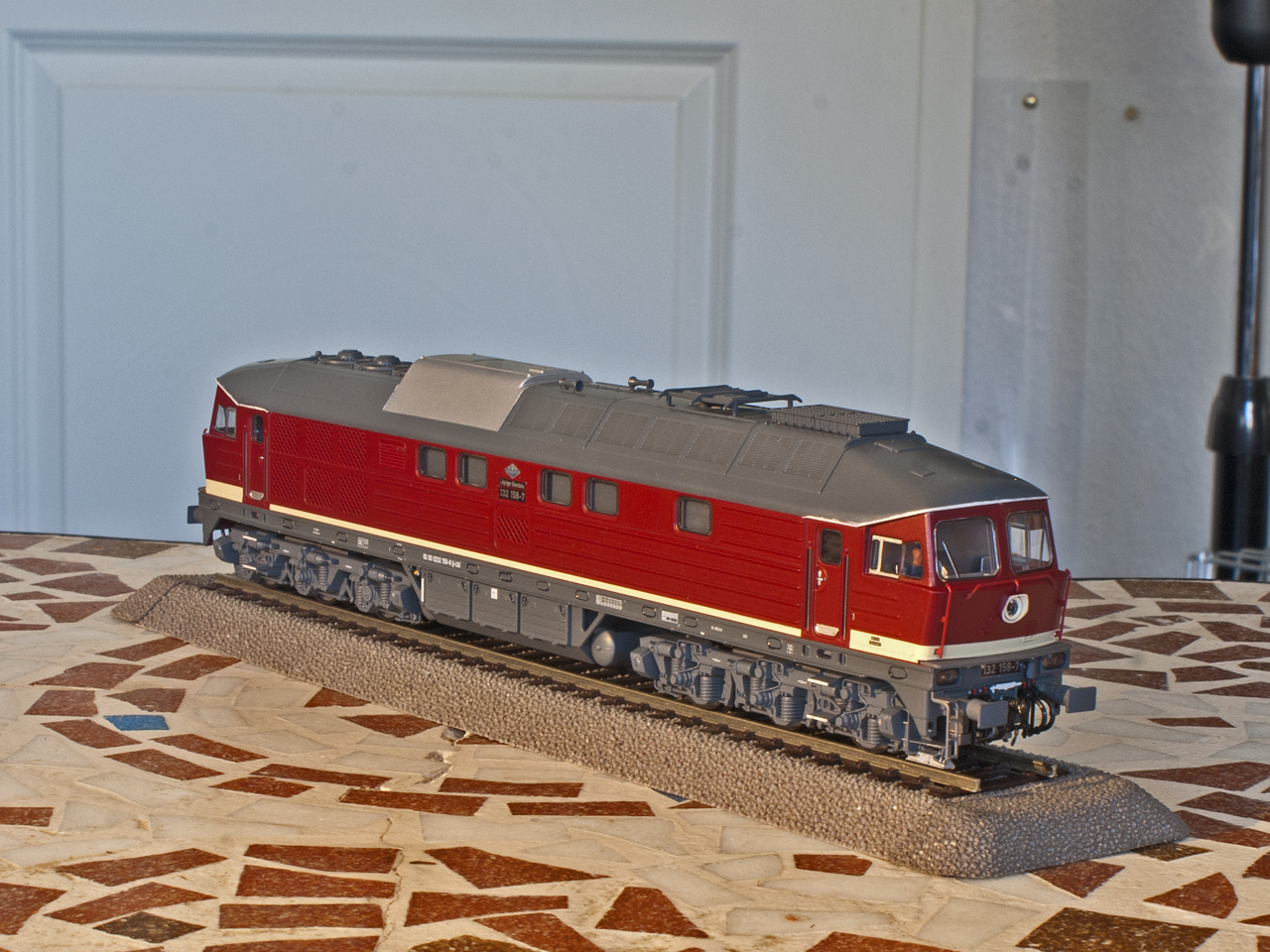
However, when looking at the finished loco, I think it was well worth the effort!
It is worth noting that Leipziger Eisenbahn's motive power inventory consists mainly of used ex-DR locomotives – specifically, four class 203 (DR V100 type) diesel-hydraulics, two class 232 diesel-electrics, and most recently, two class 155 electrics. All of these have been painted in now-historic liveries, with the 203s, 232s and 155 137 wearing the classic burgundy livery with white trim, and 155 078 having been painted oriental red with her last revision. It's also interesting that those locos which have been given back their Deutsche Reichsbahn livery have also been given back their DR style running numbers. Consequently, the locomotive known as 232 158-8 in Deutsche Bahn service has been restored to her appearance as 132 158-7.
132 158 was built in 1974 and accepted by Deutsche Reichsbahn on 29 January, 1975. Its works number is 0373.
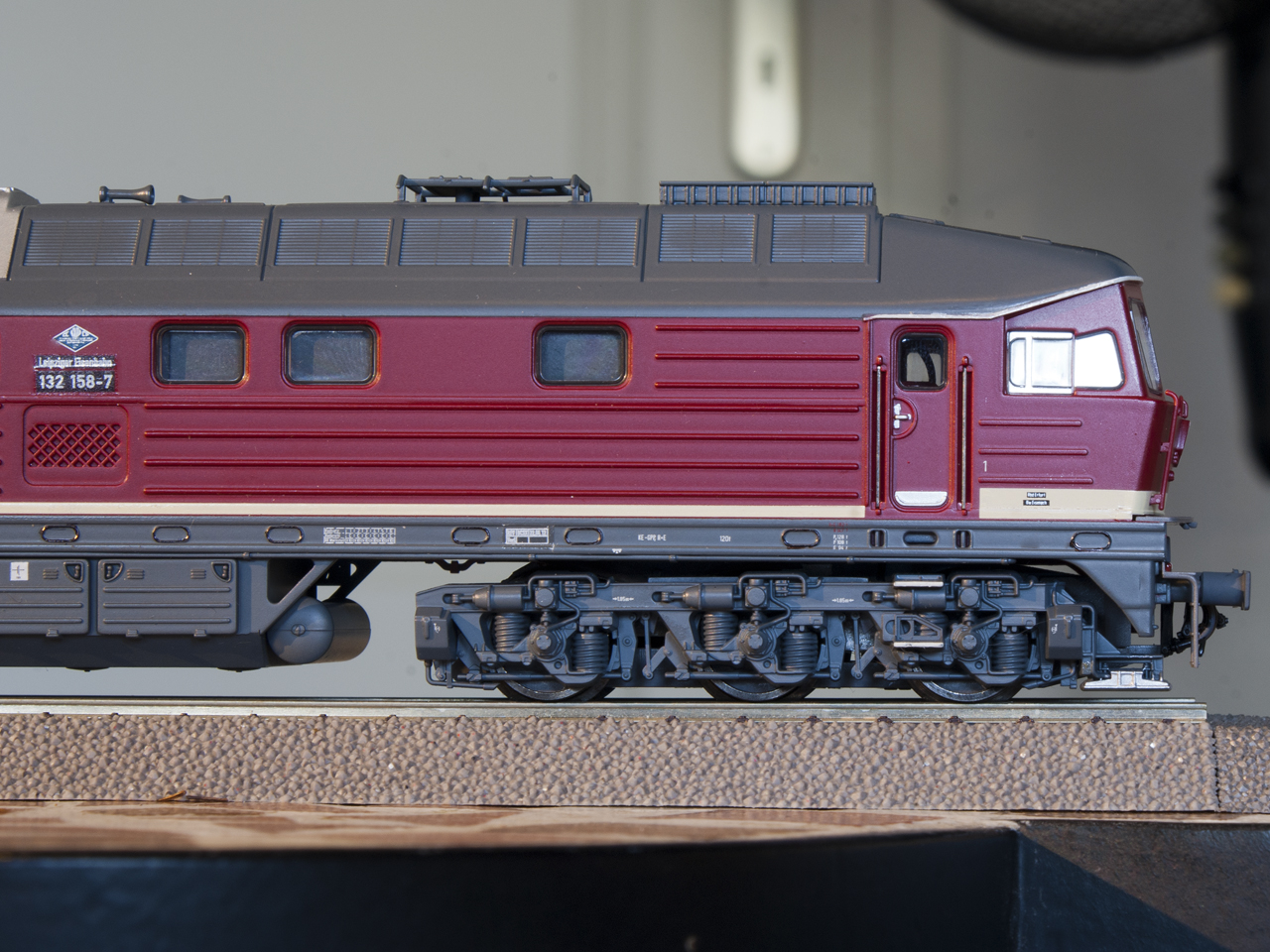
There were two variations of the burgundy and grey livery on the 132s – one with the trim stripe narrowing in between the cab doors, the other with a broad stripe all around.
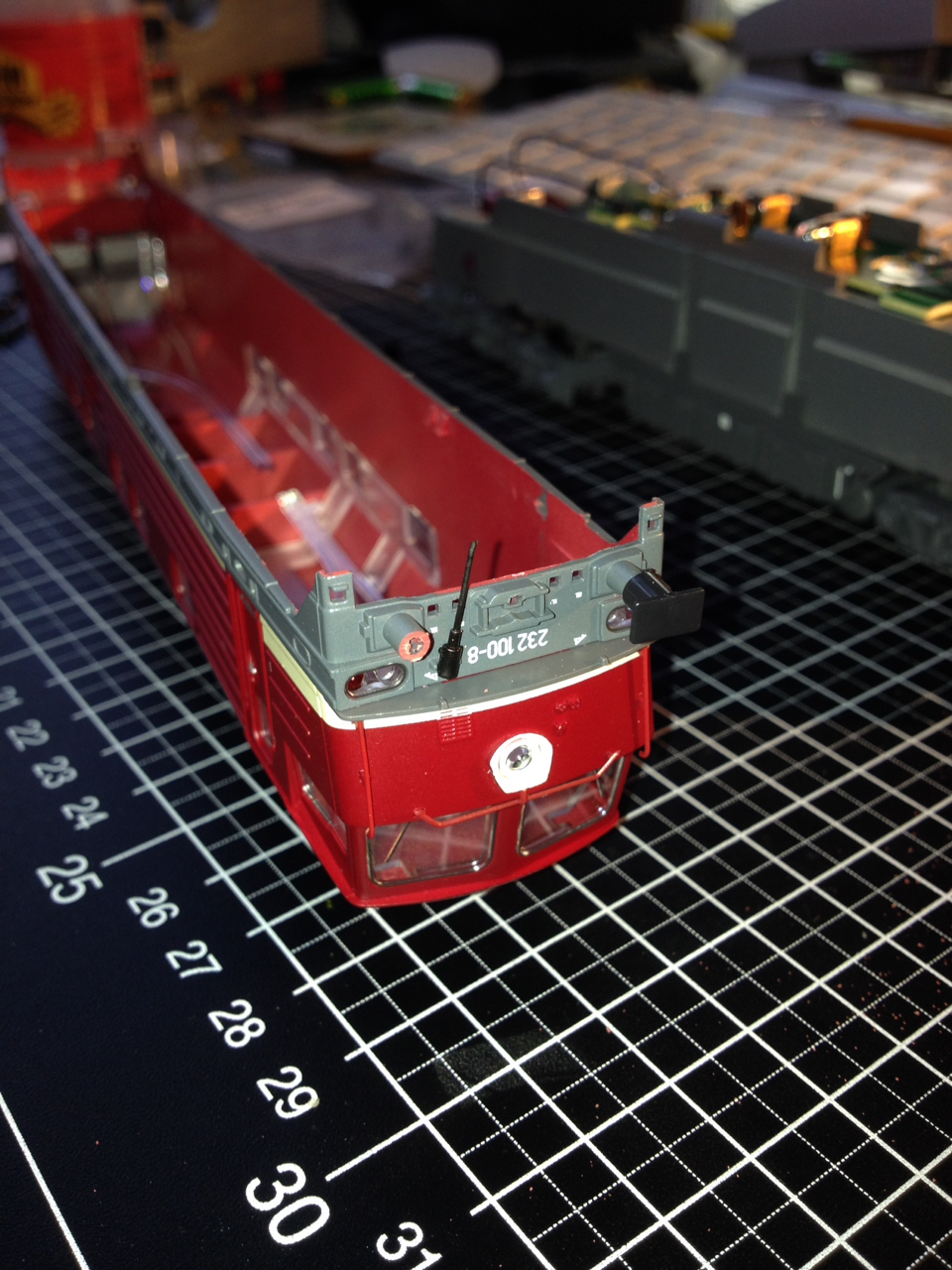
This snapshot was taken in the middle of modding. Using a razor saw, I cut off about one millimetre of plastic from the bodyside part of the buffer shafts. These shafts had been hollow to accept the retaining pins for the round buffers.
As the rectangular buffers I had obtained as spare parts from Roco were designed to be plugged onto retaining pins themselves, I took some sprues from detailing parts sets which I had stashed in my scrapbox, and cut straight pieces from these sprues to fabricate retaining pins with matching diameter. I first glued these in place inside the buffers proper, and after that glued these into the buffer shafts on the model's body.

The decals for this specific loco were again provided by Mr Nothaft of http://www.modellbahndecals.de/index.php . I did find out that some of the smaller servicing inscriptions on the solebars are formatted slightly differently now than they were in the DR era, so I will need to amend these in due course.
Going by 132 158's EVN number, the locomotive is registered as 92 80 0232 158-8 D-LEG.
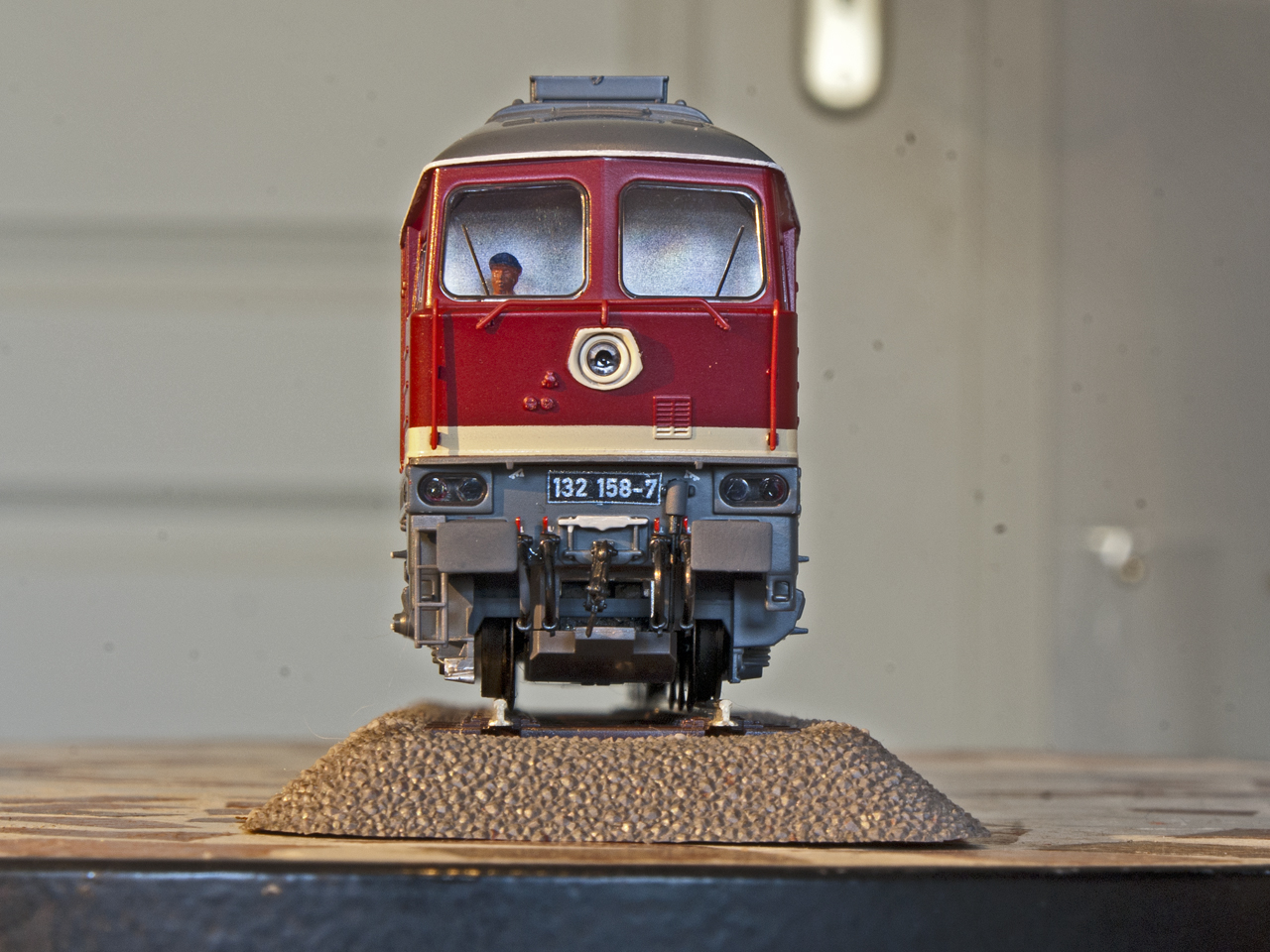
Thinking about it, I might yet prepare roller blinds for the cabs as well! And, perhaps I will yet check whether there may be suitable photo-etched windscreen wipers...
Another item I had to modify on the model was painting the rain gutters above the cab windows off-white.
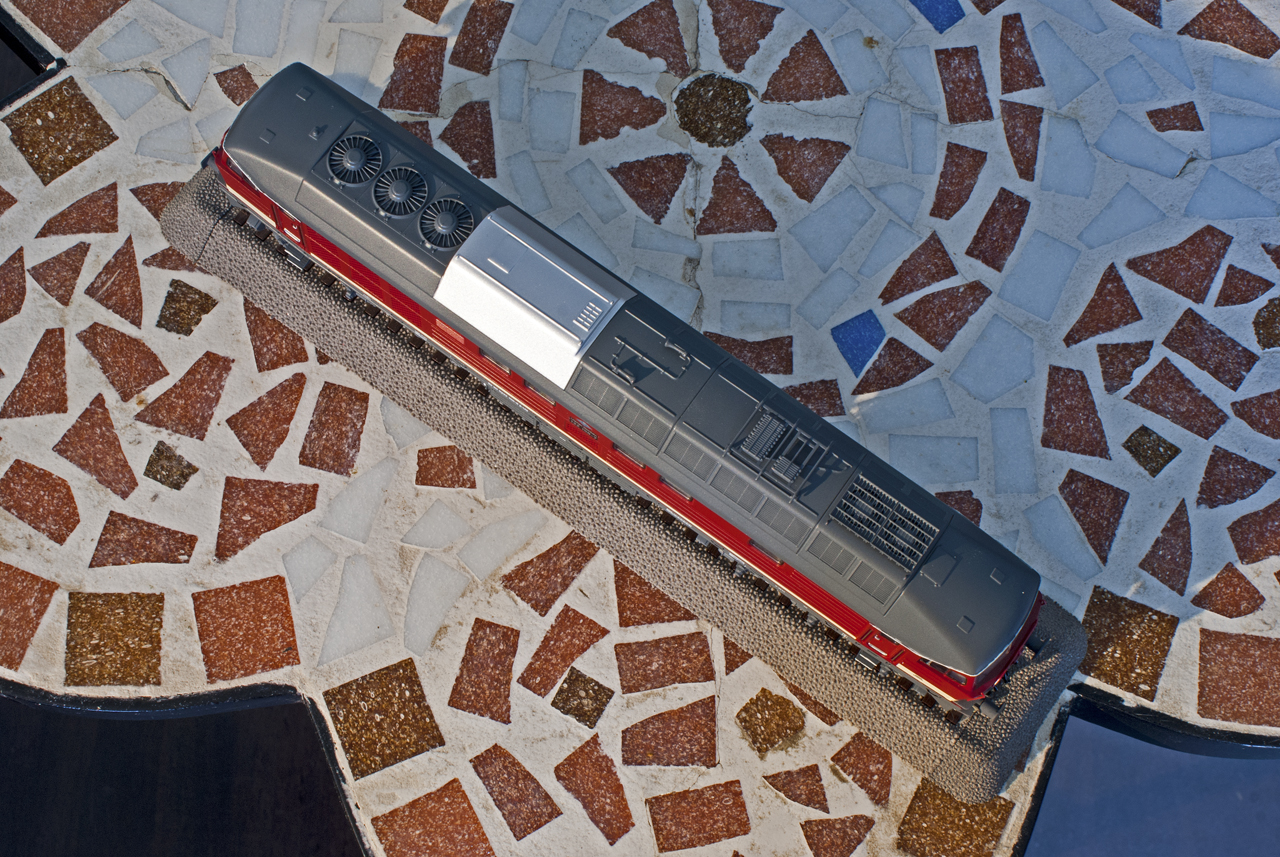
Various structural details differed during the 132/232's extensive production run. Early 132s, for example, had the radiator fans on the Cab 2 end set within raised, cylindrical tubes, while later locos had them set almost flush with the roof panelling.
And to round things off, I recommend you have a look at these Youtube videos showing 132 158 at work:
Cheers everyone!
-
 2
2




2 Comments
Recommended Comments
Create an account or sign in to comment
You need to be a member in order to leave a comment
Create an account
Sign up for a new account in our community. It's easy!
Register a new accountSign in
Already have an account? Sign in here.
Sign In Now